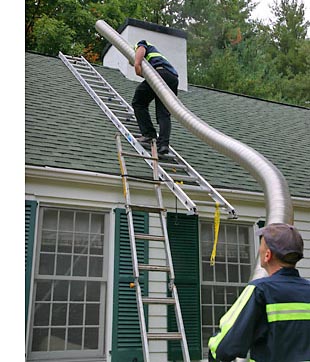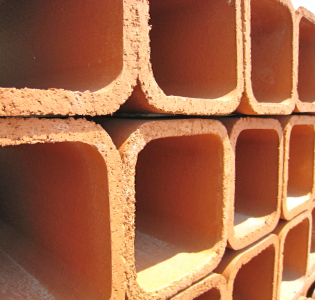Why should I care about my Chimney Liner
What exactly is a Chimney Liner and Why Should I Care?
by Dave Lamb – dave@mychimneys.com
 Chimney liners are an important safety feature and protective layer of chimneys that many know little about. The chimney liner is the material that covers the inside of the chimney flue to protect the chimney from combustion products and allows for the materials to be expelled through the top of the chimney without a problem. Your chimney liner may be built into the chimney or it could have been put in on a later date, but today, all chimneys should have an adequate liner for their fireplace or burning appliance.
Chimney liners are an important safety feature and protective layer of chimneys that many know little about. The chimney liner is the material that covers the inside of the chimney flue to protect the chimney from combustion products and allows for the materials to be expelled through the top of the chimney without a problem. Your chimney liner may be built into the chimney or it could have been put in on a later date, but today, all chimneys should have an adequate liner for their fireplace or burning appliance.
 Almost all new chimneys are required by law to be lined today, but before the 1940s, chimney liners were not standard in new homes. It is no coincidence that before 1950 there were also many more chimney and house fires. Chimney liners protect the inside of the chimney from deterioration that can allow sparks, fumes and combustibles into the surrounding walls, attic or roof. This often neglected feature is a very important part of every home that has a chimney.
Almost all new chimneys are required by law to be lined today, but before the 1940s, chimney liners were not standard in new homes. It is no coincidence that before 1950 there were also many more chimney and house fires. Chimney liners protect the inside of the chimney from deterioration that can allow sparks, fumes and combustibles into the surrounding walls, attic or roof. This often neglected feature is a very important part of every home that has a chimney.
Wear and tear from normal use can cause deterioration of the liner by opening cracks in chimney liners made of tile. Combustion gases and the rain can also cause eroding in the joints between the brick or stone. If there is deterioration or improperly built lining discovered there are a few options on how to solve this problem. You can remake the existing flue with a new clay liner, reinforce the chimney and build a new liner with poured cement, or reline the existing flue with a new metal flue liner. Any method you choose will be an important beneficial procedure for your chimney maintenance.
Clay Tile Liners
Clay tile liners have been used since the 1900s and this material is still used today. The tiles are stacked on top of one another and the joints are sealed with mortar. The clay tiles can withstand tremendously high temperatures with almost no impact on the performance of the liner. Also, all of the harsh materials burned make no difference to the soundness of the structure when using a clay tile liner. The clay tile liners last about 50 years if they are installed correctly.
 Material costs for clay liners are relatively inexpensive. It’s not all good news though. While the materials are a cost effective way to add a new liner, the installation cost can be prohibitive for many homeowners. The installation process is complex. It is best to install this liner with the installation of the chimney. But to build a new clay liner or to replace or fix an existing one, it is a difficult task. Even with the simplest straight chimney the old tiles must be removed first. This can be accomplished by your chimney professional using specialized tools to chip out pieces from the top of the chimney. Sometimes the chimney walls must be broken through every few feet to take out the old flue and install the new one. And when the chimney is crooked or contains “offsets”, it makes the process much more difficult. In this case the tiles need to be cut in a precise manner to fit exactly together within the flue and this takes an experienced professional. The installation process is tedious, especially for non standard flues that change direction up the chimney shaft. Also, the tile shape is not the best. The square and rectangular shaped tiles do not create a smooth interior. For this reason, air gets caught in the spaces between tiles and it may also affect the draft in your chimney. A round liner may be a better option. This is not a home repair job to take on in your free time; hiring a professional is a must for this difficult installation.
Material costs for clay liners are relatively inexpensive. It’s not all good news though. While the materials are a cost effective way to add a new liner, the installation cost can be prohibitive for many homeowners. The installation process is complex. It is best to install this liner with the installation of the chimney. But to build a new clay liner or to replace or fix an existing one, it is a difficult task. Even with the simplest straight chimney the old tiles must be removed first. This can be accomplished by your chimney professional using specialized tools to chip out pieces from the top of the chimney. Sometimes the chimney walls must be broken through every few feet to take out the old flue and install the new one. And when the chimney is crooked or contains “offsets”, it makes the process much more difficult. In this case the tiles need to be cut in a precise manner to fit exactly together within the flue and this takes an experienced professional. The installation process is tedious, especially for non standard flues that change direction up the chimney shaft. Also, the tile shape is not the best. The square and rectangular shaped tiles do not create a smooth interior. For this reason, air gets caught in the spaces between tiles and it may also affect the draft in your chimney. A round liner may be a better option. This is not a home repair job to take on in your free time; hiring a professional is a must for this difficult installation.
Cast-in-Place Liner
When it doesn’t make sense to replace the entire flue with new tiles, a cast-in-place liner may be the option to consider. This option is perfect for creating a new flue inside of damaged masonry. Similar to the clay flues, cast in place liners are not affected by the heat or harmful gases put off from the fire below. For this reason, they are very durable. Due to the protection from extremely high temperatures that cast in place liners provide (because they offer better insulation), fires typically burn cleaner and also acquire less creosote buildup as a result. Cast-in-place liners also have about the same long life as the clay liner. The process for installing a cast-in-place liner, while less invasive than the clay liner, is still a difficult task and one to be taken on only by professionals who possess one of the proprietary methods for installation. One uses an inflatable bladder that is put down the chimney with mortar poured around it to form a round opening for your flue. Another method uses a vibrating bell-shaped piece that is pulled up from the bottom of the chimney slowly while the mortar is poured around it producing a round opening right up to the top.
One advantage to a cast-in-place is that it will increase the structural integrity of a chimney that is in poor condition. In many cases however, the cost to rebuild the chimney is close to the cost for the cast-in-place liner. Older homes or historic properties may need to opt for this solution if they want to maintain the masonry of the original chimney.
Metal Flue Liner
 There are many different shapes and varieties of metal flue liners. While the most common are the stainless steel liners, other materials can also be used. The two types of metal liners are rigid and flexible. The type your chimney professional will choose to use will depend on the shape of your chimney. Rigid liners are used in chimneys that are completely straight with no off-sets or bends. While both liners provide proper protection, one advantage of the flexible liner is that it may hold less build up because it expands and contracts with the temperatures of the chimney thus knocking off any creosote or other build up. The most common problem metal flues have over time is corrosion. To prevent this, your chimney professional must use care in selecting the correct alloy to coincide with the type of fuel burned. Insulation can also be used with metal liners. The insulation can help to keep higher temperatures in the chimney and also helps to get rid of condensation that may cause corrosion over time in the chimney.
There are many different shapes and varieties of metal flue liners. While the most common are the stainless steel liners, other materials can also be used. The two types of metal liners are rigid and flexible. The type your chimney professional will choose to use will depend on the shape of your chimney. Rigid liners are used in chimneys that are completely straight with no off-sets or bends. While both liners provide proper protection, one advantage of the flexible liner is that it may hold less build up because it expands and contracts with the temperatures of the chimney thus knocking off any creosote or other build up. The most common problem metal flues have over time is corrosion. To prevent this, your chimney professional must use care in selecting the correct alloy to coincide with the type of fuel burned. Insulation can also be used with metal liners. The insulation can help to keep higher temperatures in the chimney and also helps to get rid of condensation that may cause corrosion over time in the chimney.
Metal liners are usually the best option for chimneys that do not already have a liner or as a liner replacement. Chimneys without bends and twists are the simplest to install a metal liner into but this is a practical and moderately priced solution for most chimneys.
There are a couple of different choices when it comes to installing a new chimney liner or fixing up an already existing one. Have a chimney professional take a look at your chimney to determine which option is the best fit for your home. While there is some leeway in which option to choose, it is very important to at least have some type of liner in place to protect against chimney fire and excessive wear and deterioration.
Northeastern Chimney is a Chimney Lining expert and we would be happy to inspect your existing lining and make recommendations to help you continue safe use of your fireplace, stove or furnace.
More Info – Chimney Liners / Chimney Lining


